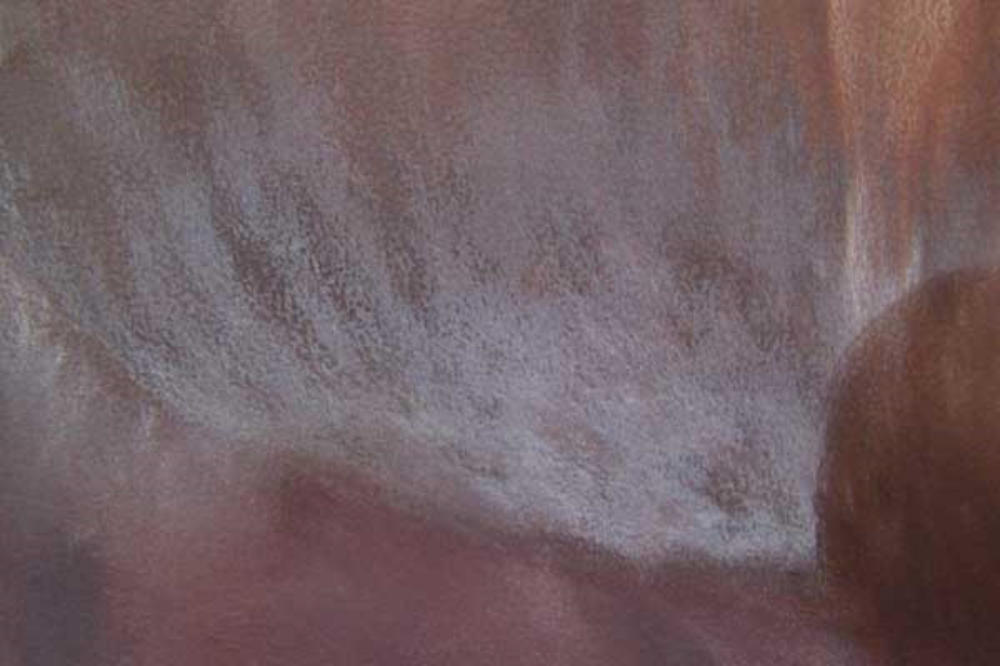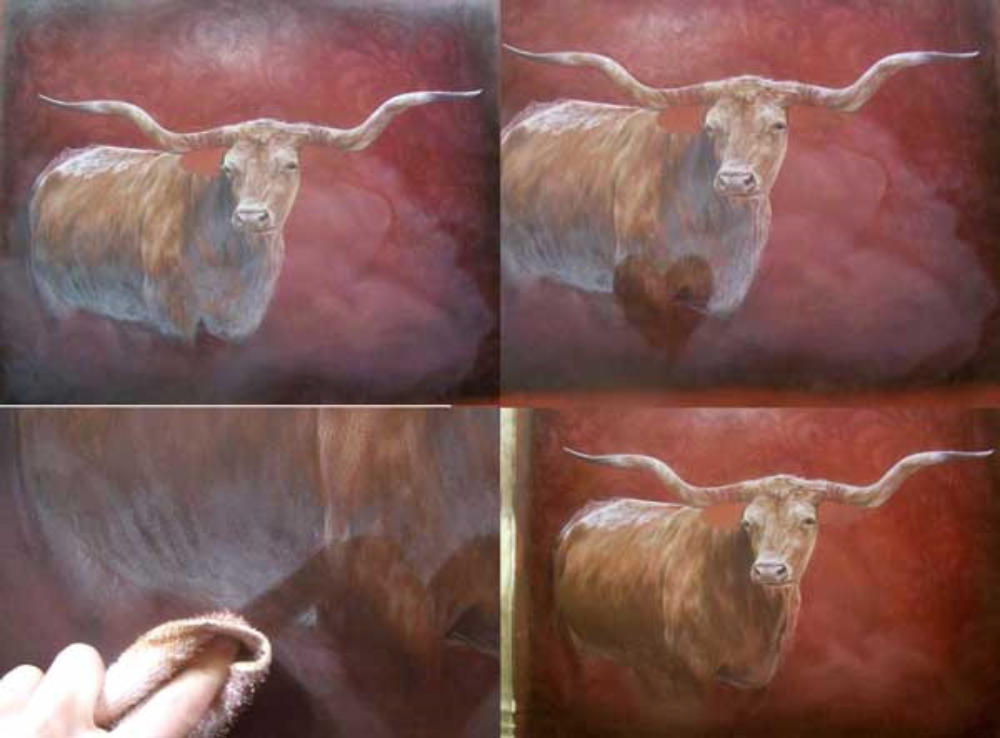- Home
- Tips & Articles
- Wax Bloom
Coloured Pencil Wax Bloom - What It Is and How to Deal With It
Has this ever happened to you?
You’ve spent hours working on a coloured pencil drawing, carefully layering rich, dark colours to create depth and contrast. You step back, feeling proud. But when you look at it the next day, a strange, hazy film has appeared over those beautiful dark sections, making them look dull and dusty.
My first thought when I saw this years ago was, "Oh no, is it mould?!"
Let me put your mind at ease right away: It is absolutely not mould (mold for my US friends) or any kind of damage.
What you're seeing is a completely normal and harmless effect called "wax bloom."
It's a common characteristic of working with many popular wax-based coloured pencils, and the great news is that it’s very easy to manage. Your artwork is perfectly safe!
In this guide, I'll show you exactly how to handle it. We will cover:
- What wax bloom is and why it happens.
- How to easily remove it.
- Effective ways to prevent it in your future drawings.
- How artist fixatives can be your ally in managing wax bloom.
So, let's start by understanding exactly what's happening.
What is Wax Bloom?
Wax bloom is a thin, often whitish or greyish, cloudy film that can appear on the surface of a coloured pencil drawing.
It tends to be most noticeable on darker colours or areas where you've applied many layers of pencil or used heavy pressure, such as with burnishing.
It doesn't damage your artwork, but it can obscure details and dull the vibrancy of your colours, making the piece look a bit dusty or muted.
 An example of wax bloom on a coloured pencil portrait, appearing as a light haze over the darker areas. Photo courtesy of Brandy Perez.
An example of wax bloom on a coloured pencil portrait, appearing as a light haze over the darker areas. Photo courtesy of Brandy Perez.Why Does Wax Bloom Happen? The Role of Pencil Binders
The primary cause of wax bloom lies in the composition of certain coloured pencils.
Wax-based Pencils
Many popular coloured pencils use a wax-based binder to hold the pigment together. This wax allows for soft cores, smooth application, and easy blending.
Brands like Prismacolor Premier and many in the Derwent range (such as Artist or Coloursoft) are well-known examples of pencils with a higher wax content. When you apply many layers of these pencils, or use very heavy pressure, some of the wax binder can migrate to the surface over time, creating the bloom.
Oil-Based Pencils
In contrast, oil-based coloured pencils (such as Faber-Castell Polychromos or Caran d'Ache Pablo) use an oil-based binder.
These pencils are generally harder, can hold a sharper point for longer, and are much less prone to causing wax bloom because they contain little to no wax that can rise to the surface.
So, if you frequently experience wax bloom, the type of pencil you're using is a key factor.
You can explore the differences further in my guide: Wax vs. Oil-Based Pencils: Which One is Right for You?
How to Remove Wax Bloom (The Simple Fix)
 This set of four images shows the process
This set of four images shows the processFortunately, removing wax bloom is usually quite easy:
- Take a clean, soft, dry cloth (a microfibre cloth works well) or a soft cotton bud.
- Gently wipe the surface of your drawing where the bloom has appeared. The haze should lift away easily.
- Be Aware: While this removes the visible bloom, on pieces with very heavy wax application, it might reappear over time if the artwork isn't sealed.
 This is the completed picture, 16 x 20 inches on rust coloured Colorfix
This is the completed picture, 16 x 20 inches on rust coloured ColorfixFrequently Asked Questions FAQs
What exactly is wax bloom?
What exactly is wax bloom?
It's a harmless, cloudy film that appears when the natural wax binder in some coloured pencils slowly rises to the surface.
It doesn't mean you've done anything wrong; it's just a characteristic of wax-based pencils. It can make your colours look a bit dull or dusty, but it’s easily fixed.
Is wax bloom the same as mould? How can I tell the difference?
Is wax bloom the same as mould? How can I tell the difference?
Absolutely not, and this is the most important thing to remember!
- Wax bloom is waxy or slightly greasy, has no smell, and wipes away cleanly with a soft cloth.
- Mould would likely be fuzzy, patchy, or stain the paper, and would have a distinct musty smell. If you see this, it’s a moisture problem, not a pencil problem.
Will wax bloom damage my drawing?
Will wax bloom damage my drawing?
No, not at all. It doesn't damage the paper or the pigment underneath. It's purely a surface issue that can hide the beautiful details and colours in your work
What’s the easiest way to remove it?
What’s the easiest way to remove it?
Gently wipe the area with a clean, dry, soft cloth. A microfibre cloth (like the one you'd use for glasses) or even a simple cotton bud for smaller areas works perfectly. Use a light touch; you don't need to scrub.
Will the wax bloom come back after I wipe it away?
Will the wax bloom come back after I wipe it away?
Yes, it sometimes can, especially in very dark or heavily layered areas. Wiping it removes the wax from the surface, but if there is still excess wax within the layers, it may reappear over time. The permanent solution is to seal the drawing.
Can I use fixative to stop wax bloom for good?
Can I use fixative to stop wax bloom for good?
Yes, this is the best long-term solution. A good quality artist's fixative will create a barrier that stops the wax from rising to the surface. However, always test the fixative on a scrap piece of paper first. Some sprays can slightly change the paper's sheen or deepen the colours, so you want to know what to expect before applying it to your finished artwork.
Which pencils are most likely to cause it?
Which pencils are most likely to cause it?
Pencils with a softer, wax-heavy formula are more prone to wax bloom. Brands like Prismacolor Premier are well-known for it. On the other hand, oil-based pencils, like Faber-Castell Polychromos, very rarely, if ever, have this issue.
How can I prevent wax bloom while I’m working?
How can I prevent wax bloom while I’m working?
You can minimise it with a few simple techniques:
- Build up your colours with several light layers rather than one or two heavy ones.
- Try not to burnish (press very hard) too much, as this pushes a lot of wax into the paper.
- Consider using an oil-based pencil for your final dark layers.
Preventing Wax Bloom in Your Artwork
While you can remove bloom after it appears, preventing it in the first place is often preferable.
Here are some strategies:
Light Layering Technique:
One of the most effective ways to minimize wax bloom is to build up your colours using multiple light layers of pencil, rather than fewer heavy ones. This reduces the amount of excess wax sitting on the surface. (For more on this, see our Layering Guide).
Pencil Choice Considerations:
If you know a piece will involve very heavy application or a lot of burnishing in dark areas, you might consider using oil-based pencils for those sections, or for the entire piece, to reduce the risk of bloom.
Using Artist Fixatives
Fixatives can be very effective in both preventing wax bloom and stopping it from returning after you've wiped it away.
Understanding and Using Artist Fixatives for Wax Bloom
Artist fixatives are sprays designed to create a clear, protective film over your artwork. When it comes to wax bloom, they work by sealing the pencil layers, preventing the wax from migrating to the surface.
For a comprehensive guide on choosing, testing and safely using all types of artist fixatives please see our main Fixative Spray guide here.
Types of Fixative
Workable Fixative
This type is designed so you can still apply more layers of pencil over it if needed.
Applying a light coat of workable fixative between some layer sets during your drawing process can sometimes help manage bloom in areas prone to heavy build-up.
It can also add a little "tooth" back to slick areas.
Final Fixative
This is applied once your artwork is completely finished. It provides a more permanent seal for protection and can prevent wax bloom from appearing or reappearing.
Best Practices for Applying Fixative:
- ALWAYS Test First: Before spraying your finished artwork, test the fixative on a scrap piece of paper with the same pencils and similar layering. This helps you check for any unexpected changes in colour or finish.
- Good Ventilation: Use fixatives in a well-ventilated area, ideally outdoors or near an open window. Follow all safety instructions on the product label.
- Multiple Light Coats: It's much better to apply 2-3 light, even coats than one single heavy coat. A heavy coat can cause pooling, running, or create an uneven, overly shiny surface.
- Correct Distance and Motion: Hold the can upright at the distance recommended by the manufacturer (usually around 20-30cm or 8-12 inches). Spray with a steady, sweeping motion, starting and stopping the spray just off the edges of your artwork.
- Dry Completely: Allow each coat to dry thoroughly before applying the next or handling the artwork.
Avoid Hairspray! Please don't be tempted to use hairspray as a cheap alternative. It is not designed for archival art purposes, can yellow over time, become sticky, and may damage your artwork.
Fixative Brands and Considerations (UK/Europe Focus)
Choosing a fixative can sometimes involve personal preference and experimentation. Here are a few commonly mentioned brands:
- Daler-Rowney Perfix Colourless Fixative: A widely available option in the UK.
- Winsor & Newton Artists' Fixative: Another common brand. Note: With any fixative, some artists report slight colour shifts on certain pigments, especially very vibrant reds or purples. Testing is always essential.
- Lascaux Fixativ (Spray or Liquid): Often highly regarded by coloured pencil artists for its quality and minimal impact on colours, though it tends to be a more premium-priced option.
- SpectraFix Degas Pastel Fixative: This is a casein-based (milk protein) fixative in a pump spray, not an aerosol. Some artists prefer it as it's less odorous and considered more environmentally friendly. It generally doesn't alter colours but may leave a slightly different surface finish compared to aerosol fixatives.
(USA Context, for readers purchasing online): Krylon is a popular brand in the USA with various fixative options. As always, testing is recommended.
- Key Advice: The "best" fixative often comes down to your specific pencils, paper, and desired finish. Testing samples is the most reliable way to find your favourite.
What's Next on Your Coloured Pencil Journey?
Understanding and managing wax bloom is a fantastic step in refining your coloured pencil skills! Here are a few places you might find helpful to explore next, to build on what you've learned:
- Master Light Layers to Prevent Bloom: One of the best ways to prevent wax bloom is by building up colour with light pressure. Dive deeper into The Essential Guide to Layering Coloured Pencils to refine this core technique.
- Explore Different Blending Options: Heavy application during blending can sometimes contribute to wax bloom. Discover alternative Blending Methods for Coloured Pencils, including those that might reduce the risk.
- Consider Your Pencils: If wax bloom is a frequent concern, understanding the difference between wax-based and oil-based pencils can be very insightful. Our Choosing Coloured Pencil Brands: A Beginner's Guide discusses various pencil types, which could help you choose pencils less prone to blooming for future projects.
- Learn About Fixatives: As mentioned, fixatives can be a solution for wax bloom. For more detailed information, see our guide on Fixative Sprays for Coloured Pencil.
- Troubleshooting Other Common Issues: Wax bloom is just one of the challenges artists can face. For more solutions, visit our main Troubleshooting Common Coloured Pencil Issues page.
Keep Experimenting!
The best way to understand how to prevent and manage wax bloom is through practice with your own pencils and paper. Try out different pressures, layering techniques, and perhaps even different brands if you get the chance.
Have you discovered a clever trick for dealing with wax bloom, or do you have a question that wasn't covered? I'd love to hear from you!

